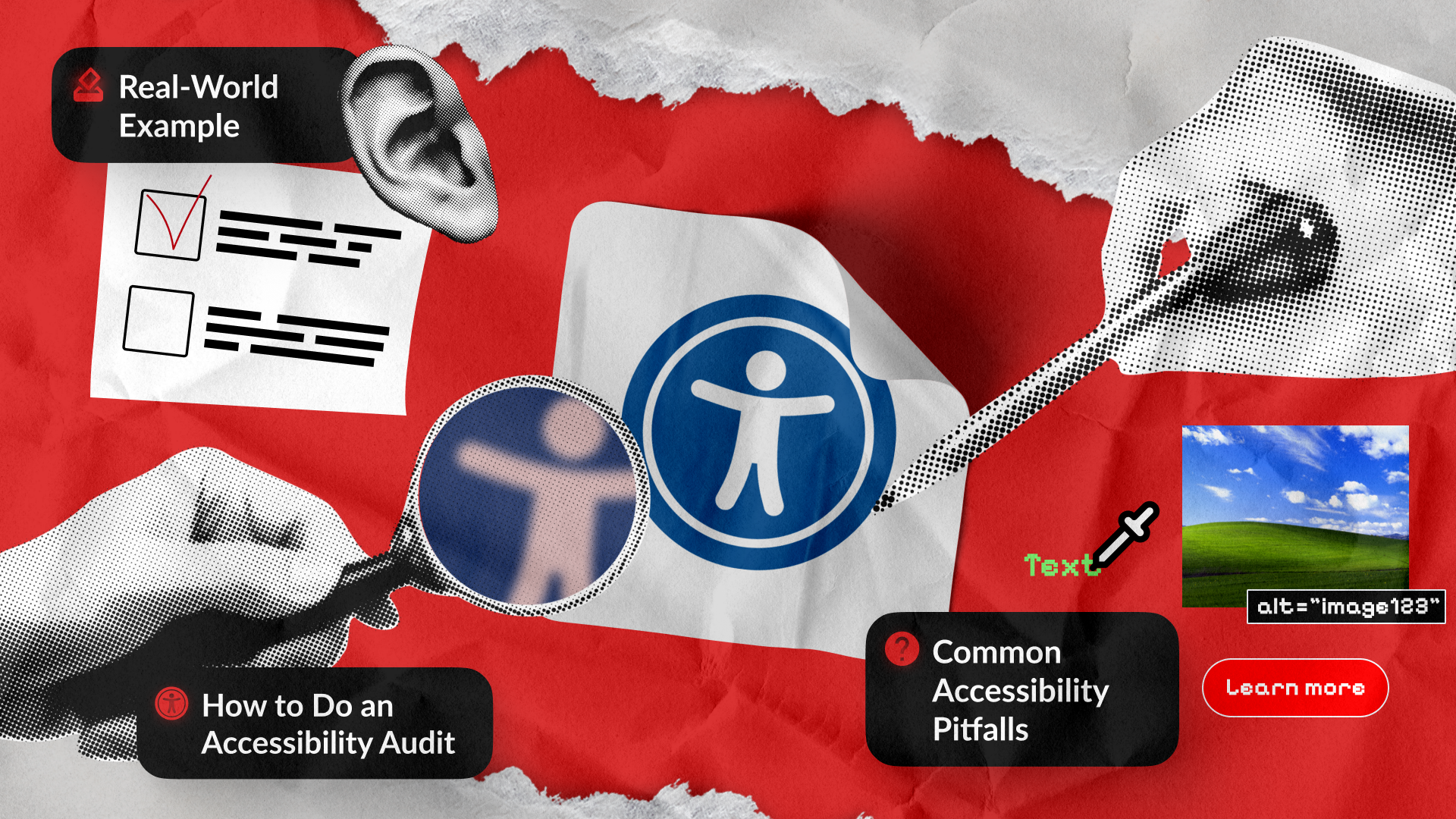Web accessibility is no longer optional, it’s a necessity. Ensuring your website’s content, structure, and features accommodate all users matters for both legal compliance and user satisfaction.
More than 28% of U.S. adults have a disability, yet many sites remain inaccessible, creating barriers and potential legal risks. Conducting a web accessibility audit identifies critical issues, from mislabeled buttons to missing captions. With a structured approach, you can bring your site closer to full inclusivity and ADA compliance.
In this guide, you’ll learn practical steps to implement or refine an accessibility audit. We’ll cover key standards like WCAG (Web Content Accessibility Guidelines), share real-world examples, and point to free or low-cost tools for automated checks. By the end, you’ll have an actionable roadmap to make your site usable for everyone—regardless of ability or device.
What Is a Web Accessibility Audit?
A web accessibility audit is a systematic review of your site’s design, content, and code that will ensure compliance with accessibility guidelines (e.g., WCAG 2.1 or ADA). An accessibility auditor checks elements like screen-reader compatibility, keyboard navigation, and color contrast, aiming to make the site inclusive for people with visual, auditory, motor, or cognitive impairments.
Why It Matters
- Legal Requirements: Failing to meet ADA or Section 508 standards can result in lawsuits.
- Expanded Audience: Users with disabilities make up a significant market segment.
- Positive Brand Image: Inclusive design highlights your commitment to diversity and equality.
Curious about broader disability challenges? See how we helped with the accessibility evaluation of 43 U.S. states’ online voter registration websites.
Key Standards & Regulations
Ensuring web accessibility means abiding by recognized guidelines and legal mandates. Meeting these criteria protects your organization from lawsuits, boosts user satisfaction, and extends your reach to a broader audience. Below are the primary frameworks shaping today’s accessibility landscape.
- WCAG (Web Content Accessibility Guidelines): Maintained by the W3C, WCAG offers success criteria at levels A, AA, and AAA. These criteria cover text alternatives for media, input navigation, color contrast, and more.
- ADA (Americans with Disabilities Act): Although originally for physical spaces, U.S. courts increasingly interpret ADA to apply to websites. An ADA compliance website audit is essential for businesses serving the public.
- Section 508: U.S. federal agencies must ensure their websites and digital content meet Section 508. Many private organizations adopt these guidelines as well, especially if they do business with the government.
- EN 301 549: In the EU, public sector websites and apps must satisfy EN 301 549, which is closely related to WCAG standards.
Before You Start: Basic Preparation
An effective web accessibility audit requires thoughtful planning. Rushing in without defining your scope or gathering the right tools can lead to confusion, duplicated efforts, or incomplete fixes. Here’s how to set yourself up for success:
- Define Scope: Decide which pages, subdomains, or user flows to audit first. Start with high-traffic or revenue-generating areas.
- Assemble Your Team: Involve developers, QA engineers, UX/UI designers, and product owners. If possible, engage actual users with disabilities for real-world feedback.
- Gather Tools: A combination of automated scanners, browser extensions, and manual testing is best. Examples include WAVE, axe, NVDA for screen-reader tests, and color contrast checkers.
- Check for Regulatory Requirements: Government sites must often comply with Section 508. E-commerce sites might face ADA lawsuits if found inaccessible.
Step-by-Step: How to Do an Accessibility Audit
Conducting a thorough web accessibility audit means combining automated checks with hands-on testing. Below is a structured, six-step approach to revealing and fixing key accessibility gaps:
Step 1: Automated Site Scan
Begin with an automated tool. You might be wondering, what’s the best option to run an accessibility checker? Commonly, you’d use:
- Browser Extensions (axe, WAVE)
- Standalone Tools (Lighthouse, Pa11y)
- CI Integrations (Continuous scanning via pipelines)
Pro: Fast detection of code-level issues (e.g., missing alt attributes).
Con: Automated checks catch only ~30% of accessibility errors.
Step 2: Manual WCAG Audit
No matter how advanced your site audit tool is, thorough WCAG auditing requires human insight. Focus on:
- Keyboard Navigation: Ensure all controls are reachable and operable via Tab and Shift+Tab.
- Semantic HTML: Proper heading order (H1-H2-H3…), label tags for forms.
- Color Contrast: Validate text meets minimum ratio (4.5:1 for normal text, 3:1 for large text).
- Multimedia Transcripts: Provide captions or transcripts for videos or audio.
Which issue type reported by the site audit tool is most severe? Often, “Critical” or “Severe” flags revolve around missed alt text on functional images, form labeling, or interactive elements lacking keyboard focus.
Step 3: Screen Reader & Assistive Tech Checks
A website that passes automated tests can still fail real user scenarios. Try:
- NVDA (Windows) or VoiceOver (Mac/iOS) for reading the entire page.
- JAWS for advanced screen reader capabilities.
- Check dynamic components (pop-ups, modals) for accessibility.
Step 4: Test with Different Devices & Browsers
Not all users have the latest Chrome version on a MacBook. Make sure to evaluate your site on all applicable devices:
- Mobile (Android, iOS with VoiceOver or TalkBack)
- Desktop (Windows screen readers, older browser versions)
- Smart TVs or e-readers if relevant
Remember, the best way to effectively perform accessibility testing is to combine device-based checks with standard user journeys, which will ensure consistent usability. Learn from our first-hand experience of when we tested Eurovision apps.
Step 5: Document & Prioritize Findings
Log each violation, referencing the relevant WCAG guideline (e.g., WCAG 2.1.1 for keyboard accessibility). Mark severity levels:
- High: Blocks essential user actions or violates fundamental compliance.
- Medium: Creates inconveniences but doesn’t break the site.
- Low: Contains minor visual or structural issues.
Step 6: Remediate & Re-Test
After completing any fixes, re-run both automated and manual checks. Validate that the new code has not introduced new accessibility bugs.
Common Accessibility Pitfalls and How to Fix Them
Even well-intentioned sites can overlook certain accessibility details, introducing barriers for users with disabilities. Addressing these typical pitfalls boosts usability for all visitors. Below are some frequent issues we’ve encountered and practical steps to resolve them:
1. Missing or Incorrect Alt Text
- Pitfall: Screen readers skip images or read cryptic file names.
- Fix: Provide descriptive alt attributes, especially for functional images (buttons, links).
2. Poor Color Contrast
- Pitfall: Low-contrast text is unreadable for visually impaired users.
- Fix: Use a contrast checker; ensure the ratio meets WCAG’s 4.5:1 standard for normal text.

3. Non-Descriptive Links
- Pitfall: “Click here” or “Learn more” offers no context to screen readers.
- Fix: Add descriptive link text, e.g., “Download annual report (PDF).”
4. Keyboard Trap
- Pitfall: Users can tab into a modal but can’t tab out.
- Fix: Ensure ESC or other keystrokes let them exit, and use focus management properly.
5. Form Labeling
- Pitfall: Unlabeled fields break screen reader flow.
- Fix: Use tags or aria-label attributes for each input and button.

For advanced auditing or conformance to ADA website compliance audit standards, QAwerk’s Accessibility Testing Services can help evaluate custom features like dynamic menus or specialized input fields.
Real-World Example: New York Online Voter Registration Site
Scenario
A busy election season loomed, and New York’s online voter registration site became a critical entry point for many first-time voters. Adding to the already existing pressure, accessibility hurdles threatened to exclude people with disabilities from this essential civic process. Early user feedback suggested the site struggled with mobile layouts, screen readers, and keyboard navigation.
Process
QAwerk ran an in-depth web accessibility audit spanning 15 core checkpoints. This mix of automated scanners, manual checks, and screen reader simulations (JAWS, NVDA) revealed over four key failures. For instance, mobile responsiveness fell short, site pages displayed poorly on a 320px width, and forms lacked clear error messages for each field.

For a deeper analysis of accessibility challenges in U.S. voter registration, check out our dedicated study: The State of Web Accessibility for U.S. Voters with Disabilities.
The ROI of an Accessibility Audit
Investing in a site-wide accessibility review will pay off in more ways than simply achieving compliance. Going above and beyond minimum standards not only prevents legal troubles, but also creates a better experience for everyone who visits your site. Here are some immediate returns you can expect:
- Legal Protection: Avoid ADA lawsuits or fines by meeting fundamental compliance.
- Better Usability for All: Accessibility improvements often benefit every user, e.g., clearer navigation or faster site speed.
- Enhanced Reputation: Being inclusive resonates with customers. Many users prefer brands that prioritize digital accessibility.
- SEO Boost: Proper headings, transcripts, and image descriptions help search engines better index content.
Conclusion
Ensuring an inclusive website isn’t just about meeting ADA or WCAG standards; it’s about creating a seamless experience for every visitor. By following the web accessibility audit steps above—blending automated scans with manual checks and tool-based analysis with real-world testing—you can transform a site from passable to truly accessible.
How to do an accessibility audit effectively? Start small, tackle glaring issues, and maintain a continuous improvement mindset. If you need an accessibility auditor to guide you, QAwerk is here to help. Our holistic approach ensures your site is both user-friendly and legally compliant, fostering loyalty among diverse user groups.
Ready to make your site inclusive for all? Let’s discuss your next audit or see how our testing services can deliver a clear path to compliance and user satisfaction — Contact us.
Learn more about the critical errors we found on the official Wisconsin voter registration website


